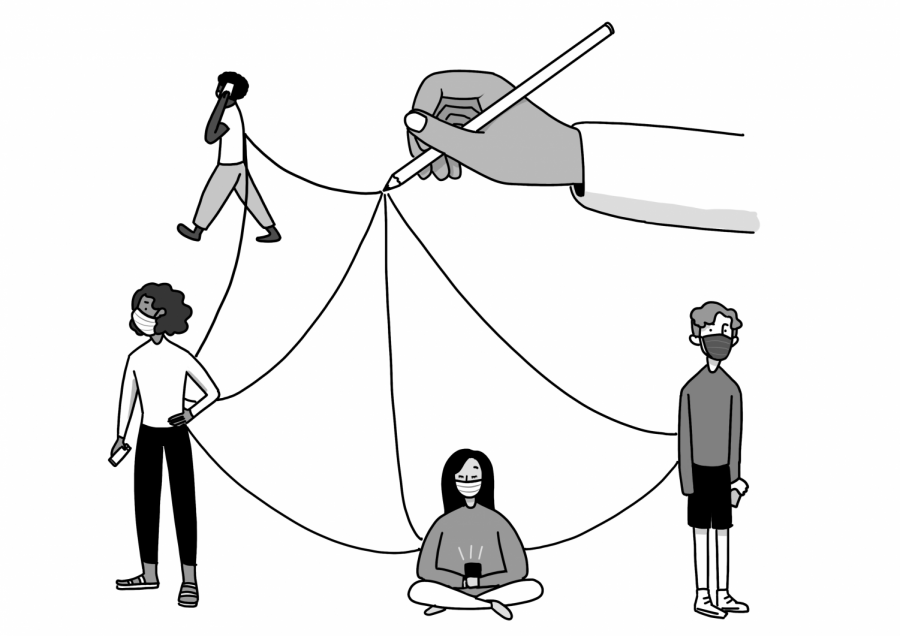A Close Consideration of Contact Tracing
The fall semester has started, and the number of new positive coronavirus cases throughout King County is decreasing. The light at the end of a very long and unpredictable tunnel is gradually becoming brighter. We’re finally emerging out of this tunnel, walking into the light of Lakeside campus in a blended learning mode. Now that Lakeside is bringing students back on campus, contact tracing will be the next critical component of a safe reopening.
There are already a number of well-established contact tracing applications. According to Lakeside’s reopening page, the Trace Innovations application will be used for contact tracing on campus. The company, Trace Innovations LLC, is a Massachusetts-based company founded in April 2020. Per the company website, the application is designed to be a “comprehensive safety monitoring solution aimed at returning students, faculty, and staff to campus safely.”
Contact tracing applications face many challenges. The first and foremost difficulty is for apps to measure proximity between users. This seems to be trivial, but in reality, the situation is much more nuanced. For one, the distance measurements of contact tracing apps need to be extremely precise, with an error margin of much less than six feet. In addition, a privacy-respecting contact tracing app should be designed to not track or store users’ exact locations, instead emitting and receiving signals from other devices through Bluetooth or other mediums, then using these signals to calculate relative distances.
In discerning proximity, there are also more complicated issues. For example, Bluetooth and GPS-based technologies pass through walls, floors, and ceilings. This would falsely sound contact alarms between people who are physically close but separated by classroom walls. Unfortunately, the Trace Innovations app falls silent on this matter, not specifying technological details of implementation.
There is another interesting, but alarming, feature of the Trace Innovations app — their website states that the app “does not contact students or community members in case of an exposure to an at-risk individual, giving the administration the power to tailor their outreach when relaying sensitive information and protocols.” The bright side of this feature is that school administrators can choose the optimal time and method to inform students or staff of exposure. However, in the Tatler Poll, an overwhelming 94% of 103 respondents preferred an immediate exposure notification, rather than having the administration choose when to relay this sensitive information; the purpose of contact tracing is instant notification of risk.
Another concern about the Trace Innovations app arises from an inconsistency between Lakeside’s description of the app and Trace Innovations’ Privacy Policy. The August 12th Lakeside reopening update states that the app “will not track a user’s movement but will connect when a user comes within 6 feet of another Lakeside user.” On the other hand, Trace Innovations’ Privacy Policy says that they “collect the precise location of your device when the App is running in the foreground or background, or when the App is closed.” It elaborates that while one can indeed disable location sharing via operating system settings, “location is core to our Services and without it, one may not be able to successfully use our Services.” This discrepancy between the reopening page’s description and Trace Innovations’ website may lead to misunderstanding or misuse.
Fortunately, Lakeside students are generally in consensus that this sort of location data tracking is acceptable in these extreme circumstances. As one Lakesider noted in the Tatler Poll, “we need people to step in and take charge, even if it might seem a little intrusive or uncalled for.” Another student views it as a trade-off between privacy for individuals and general well-being for society, saying that “either the government/organizations know more about you than is ideal, or we have to stay at home, people lose their jobs and kids lose their educations, and the economy shuts down.” From the responses of the Tatler Poll, most individuals do not mind sacrificing a small amount of privacy for the greater good of public health.
Lakeside requires all students and staff to participate in contact tracing for safety measures on campus, from 8 a.m. to 4 p.m. Polled in early September, 96% of 81 respondents support the usage of contact tracing inside of school. However, students are split over the specific scope of the app. Around 56% advocate for contact tracing to be used both on- and off-campus, while another 40% believe that contact tracing apps should be confined on-campus only. Generally, those who support on campus-only usage are in doubt of the efficacy of off-campus measures. Since this app will be used almost exclusively in the Lakeside bubble, keeping such an app open off-campus is practically useless.
We looked into several other reputable contact tracing apps, such as the Exposure Notification System, developed by technology giants Apple Inc. and Google. It does not collect users’ geographical location and keeps user identity completely anonymous. Additionally, no data is visible to Apple Inc. or Google; in fact, all data is processed and stored on device, and will only be shared with public health authorities with users’ explicit consent.
Another viable contact tracing app is NOVID, developed at the Carnegie Mellon University by a team of specialists working in mathematics, human-computer interaction, and information security. NOVID is also anonymous and does not track users’ locations. It uses ultrasound and Bluetooth sensing to more accurately detect proximity between users; this also resolves the issue of detection through walls. On the other hand, data can still be shared within the community, as members “can opt-in to share their anonymous data,” NOVID’s website says. “Admins and community members with access to this dashboard can see trends to make better-informed decisions.”
Of course, in order to make any contact tracing actually useful, the app must not only be used by Lakesiders, but also by those with any possible contact in the foreseeable future with Lakeside families. This includes all Lakeside family members and friends, as well as their extended communities. The most difficult challenge of contact tracing is getting everyone to use the same application.
The coronavirus pandemic has brought about unprecedented circumstances. Contact tracing applications can inform us about risk and exposure, but there will be technological and privacy issues to consider. There is no way to make the perfect decision; with the limited resources, information, and experience that we have, we can only strive to choose the most optimal solution. However, even after the choice has been made, we cannot just sit back and let effects run their course. We should stay flexible and be ready to adjust plans when equipped with more information and better tools.


